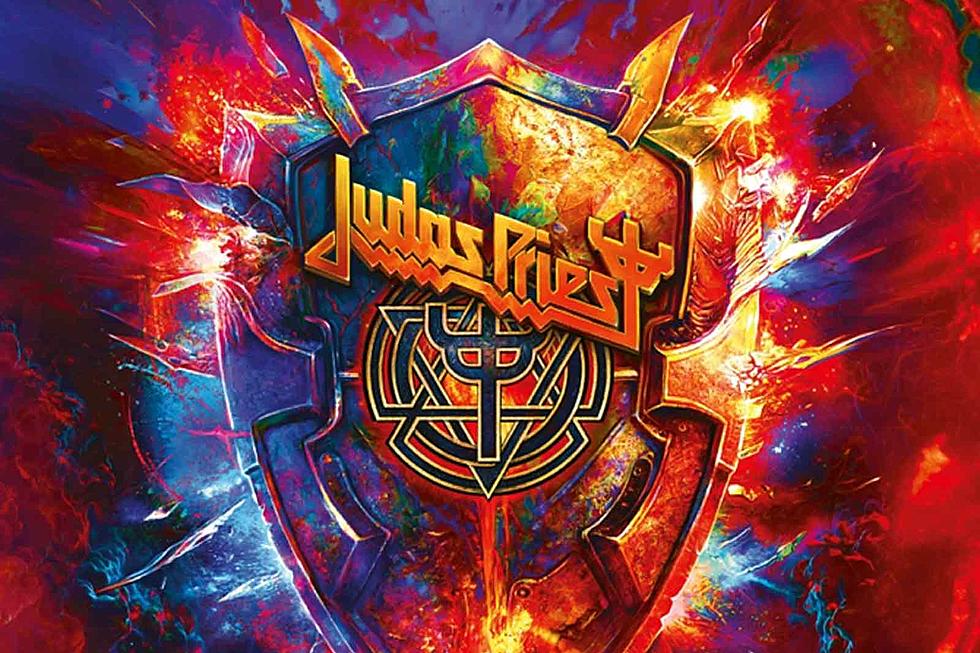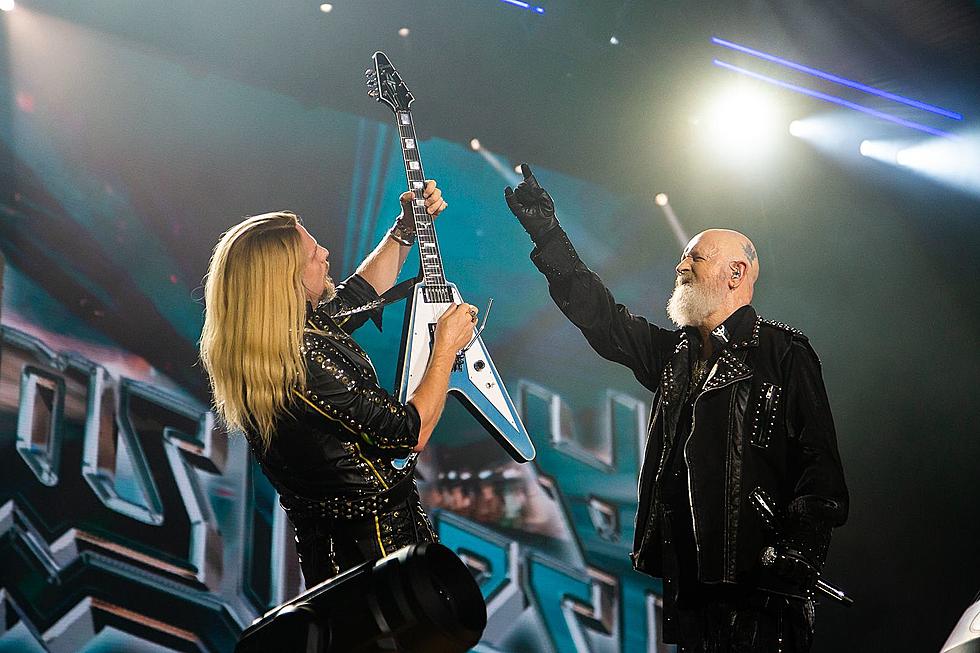
How Judas Priest Survived the ’80s
Heavy metal has been going strong since the '70s, but if you look purely at the sales figures, the style enjoyed its commercial peak during the '80s.
Though this success was enjoyed primarily by bands born in that decade (Metallica, Motley Crue, etc.), ‘70s hard rock and metal stalwarts like the Scorpions, Aerosmith and Judas Priest also achieved their largest audience and biggest sales during that time, by adapting to the changes and opportunities available to them. In Priest’s case, a stable lineup of singer Rob Halford, guitarists Glenn Tipton and K.K. Downing, bassist Ian Hill and drummer Dave Holland (who replaced Les Binks in 1979) contrasted with a surprising sonic malleability and willingness to experiment.
Then again, the Birmingham five-piece had been gradually evolving since making its recording debut on 1974’s Rocka-Rola, trying out new things with each successive album, including metal landmarks like Sad Wings of Destiny and Stained Class, and this flexibility would serve them well throughout the ‘80s.
The new decade couldn’t have started out any better for Judas Priest, whose sixth studio album, British Steel, yielded soon-to-be-signature hits like “Living After Midnight,” “Metal Gods” and “Breaking the Law,” and is still often cited as the overall best of their career. The album’s arrival on April 14, 1980, was serendipitous, allowing the band to capitalize on the red-hot New Wave of British Heavy Metal, which had gathered strength in the waning months of the '70s.
Watch Judas Priest's Video for 'Breaking the Law'
By spring of the following year, hungry young bands like Saxon, Def Leppard and Iron Maiden were riding its crest with brand new albums of their own, and Maiden, most of all, soon revealed their inspirational debt to Priest when they secured the opening slot on the U.K. British Steel Tour. Beyond the obvious musical similarities, Maiden’s black leather outfits, silver studs and bullet belts revealed that Halford’s penchant for gay S&M wear had been adopted by their heavy metal understudies, becoming the virtual uniform of the N.W.O.B.H.M. and offering a fashion touch point for thrash (denim and leather) and glam (add colors and lace to the mix) alike.
For Priest, British Steel's unprecedented success in the U.S. (peaking at No. 34 on the Billboard chart) would mark a turning point in their career ambitions. Though they’d harbored dreams of conquering America pretty much since landing at CBS Records in 1977, only now did those dreams truly seem within their grasp, as radio stations started putting their latest songs into heavy rotation.
By the end of 1980’s extensive touring run, which culminated with an appearance at the first Monsters of Rock festival (alongside Rainbow, Scorpions and others) British Steel was nearing platinum sales in the U.S. -- a first for Priest. One would expect that the band now had a pretty clear plan for building on that momentum with its next album, but that was hardly the case.
Instead, 1981’s Point of Entry turned out a confused and schizophrenic album. Its songs seemed torn between repeating the last album’s hook-laden hard rock hits (see “Don’t Go,” Hot Rockin’” and the excellent “Heading Out to the Highway”) and reviving some of the progressive ingredients that had characterized their ‘70s work (“Solar Angels,” “Desert Plains”), ultimately pleasing fewer fans in either camp.
Watch Judas Priest's 'Heading Out to the Highway' Video
As Halford later admitted to Garry Sharpe-Young in the book Metal: The Definitive Guide, “We were really scratching our heads with Point of Entry. The band wanted to do something different, but the record company had seen we could deliver hit singles and wanted more of the same. We were not so sure, so I think Point of Entry suffers from too many people pulling in too many directions.”
Be that as it may, the album still went gold and answered Priest’s doubts as to their best course of action, musically speaking: They would own their metal gods status and come back Screaming for Vengeance.
The arrival of Priest’s eighth studio album, in July 1982, solidified their commitment to representing the “classic” heavy metal template for the decade, both sonically (more power) and visually (more leather), backed by a striking album cover depicting a stylized eagle transformer (they even gave it a name: the Hellion) that appealed squarely to teenage and preteen boys. Musically, the album boasted another set of career-defining numbers in “Electric Eye” and the title track, while delivering an all-important single in the irresistible sing-along “You’ve Got Another Thing Comin’,” which cracked the Billboard rock chart’s Top 5.
Watch Judas Priest's Video for 'You’ve Got Another Thing Comin''
“Who knew that the [album’s] eighth track was going to be the song that would catapult the band into such success in America?" Halford told Guitar World. "'Cause that track was buried. Normally, the tracks you think are going to do stuff are at the front end of the release. But our friends at [the label] said, ‘We're going to go for this song.’ And we didn't really know what was going on. But then the feedback was coming over: ‘Hey, the record's buzzing in this town and that town,’ and it just took off.
Perhaps even more significantly, this breakthrough hit received strong rotation on the nascent MTV (launched just one year earlier) and showed Priest that music videos would be a dominant marketing tool in the immediate future – a lesson they would apply to their advantage before too long. But not before staying the course, by and large, for one more effective exercise in classic metal branding on 1984’s Defenders of the Faith (see the cover art’s newest transformer/monster, the Metallian!), which proved just as popular with Priest’s die-hard audience, but fell just short of its predecessor’s double platinum sales and lacked a hit on par with “You’ve Got Another Thing Comin’.”
To the record company, this translated as “disappointing,” even though the band successfully headlined arenas across the U.S. throughout 1984, and was later invited to perform at the era-defining Live Aid concert in July 1985. Where other bands may have sat on their laurels, Judas Priest’s three-headed leadership of Halford, Tipton and Downing were savvy veterans by now (a clear advantage over younger, less experienced competitors), well versed in the music industry’s “evolve or perish” realities and well attuned to commercial trends. They collectively recognized the undeniable popularity of hair metal and decided to explore it for themselves on their 10th studio album, Turbo.
In doing so, Judas Priest proved just how fearless they were about embracing change, when they adopted then cutting-edge guitar synthesizers and made Turbo (originally considered for release as a double album called Twin Turbos, so prolific were the sessions) one of history’s earliest fully digital recordings, and arguably the first by a heavy metal band. The album was heartily embraced by millions of America’s ever growing pop-metal consumer base, earning Priest an even stronger foothold on mainstream radio and MTV (with help from state-of-the-art music videos and custom-designed colorful leathers), thanks to new hits like “Turbo Lover” and “Parental Guidance” (which commented on the PMRC’s music censorship campaign of 1985).
Watch Judas Priest's 'Turbo Lover' Video
As for Judas Priest’s more traditional, heavier-leaning fan contingent, they certainly weren’t shy about voicing their displeasure with the band’s softer new direction. But the cries of “sell out” were easily drowned out by the scores of mainstream hard rock consumers who were flocking to witness Priest’s Fuel for Life tour, and a small group of these inadvertently starred in a now seminal movie document of '80s heavy metal culture called Heavy Metal Parking Lot. Even though Judas Priest’s calculated dalliance in the pop-metal movement was, by most every measure, a roaring success (further documented by 1987’s double live album Priest …Live!), the final years of the decade would be marred by difficulties and disappointments.
When the time came to figure out their next move, the members of Priest seemed unusually tentative and even unmotivated, an apt descriptions for the group’s final studio album of the decade, 1988’s oft-maligned Ram it Down. Though it displayed a halfhearted return to Priest’s more aggressive musical attributes (see “Hard as Iron” and the title track), the album was obviously a patchwork of new songs and outtakes dredged up from those inspired Twin Turbos sessions, generally leaving fans and critics unconvinced and unimpressed.
Listen to Judas Priest's 'Hard as Iron'
Behind the scenes, health issues experienced by Dave Holland (who would soon be ousted from the band) forced the use of a drum machine, and the band’s lengthy working relationship with producer Tom Allom had finally run out of steam. But maybe Halford put it best when describing the Turbo and Ram It Down eras in 2012: “When you look back at the ’80s, living through that decade, it was incredibly decadent," he said. "There was a lot of money flying around [and] it was a real pig-out in many ways, everything was larger than life.”
The '90s would usher in cultural changes that stood in direct opposition to all that – much of it reflected in the music that emerged out of Seattle and was heartily embraced by Generation X-packed college campuses. It’s no exaggeration to call this period a seismic shift that put a hard stop to many of the '80s’ most successful hit makers, particularly in the heavy metal community.
But this is where Judas Priest once again proved they were in a class of their own, shocking the heavy metal world with one of the greatest and heaviest albums of their career with 1990’s Painkiller. Just as they’d started the ‘80s on a high note, Priest did so again in the ‘90s, and while the ensuing years would see a lengthy hiatus following Halford’s departure, the band would eventually return, as strong as ever after the new millennium. Having said that, looking back on Judas Priest’s 40-plus-year career, it’s hard to make a case against the ‘80s being the British metal gods’ most fascinating and eventful period.
30 Most Outrageous '80s Rock Fashions
More From Ultimate Classic Rock









